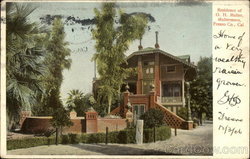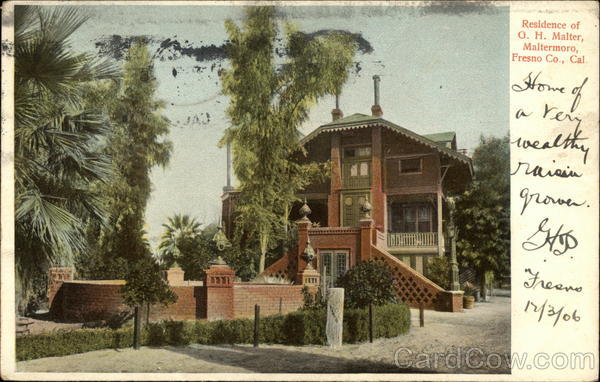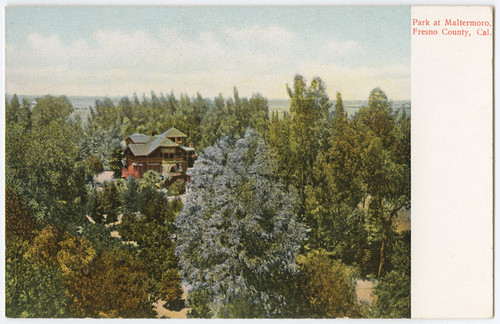George H. Malter, the owner and founder of the St. George Vineyard which was one of the largest sweet wine and brandy producing establishments in the world, was born in Silesia, Bohemia, March 25, 1852.
Educated in the Polytechnic school, he became a mining engineer and while still in his teens came to the United States, locating in Chicago for a short time, after which he came to California, via Isthmus of Panama, in 1869. One of Fortune's favorites, his success in his business ventures, was from the first assured.
He was engineer on many large mining projects and put in one of the first blast furnaces in the United States for the Union Coal, Iron and Transportation Company, at Chicago. He was engineer in the construction of the rolling mills at Joliet, Ill., and built the Marsac mills, in the silver mine at Park City, Utah, in 1872, which after all these years are still in operation. After following mining engineering all over the mining section of the Middle West and West he returned to California and began to make investments.
In 1878 he purchased his first piece of land in Fresno County, consisting of 480 unimproved acres, and from time to time added to his holdings until he owned 4,000 acres along Fancher Creek in Fresno County, 2,000 of which were planted to vines.
The St. George Vineyard was started in 1879, when 160 acres of vines were planted. It eventually comprised six vineyards, aggregating nearly 2,000 acres which were planted in choice imported varieties of wine, brandy and raisin grapes. These vineyards produced annually upward of 6,000 tons of grapes. About one-third of this amount was used for raisins.
A large quantity of table grapes were grown and shipped annually to Chicago, New York and other large cities, where they were sold at auction to fruit dealers. The remainder of the St. George Vineyard grape-product went to its winery and distillery in which about 10,000 tons of grapes were annually crushed for wine and brandy purposes. A large amount of the grapes so used were bought from neighboring vineyards during each season. The St. George Vineyard had its warehouses in San Francisco, New York and New Orleans ; its winery for making dry wines at Antioch, Contra Costa County, and its sweet wine producing vineyards, winery, and distillery at Maltermoro, Fresno County.
The first winery at Maltermoro was built in 1884. It was then a comparatively small concern, but grew to be one of the largest in the state with a capacity of working 200 tons of grapes per day, crushing 10,000 tons of grapes during the vintage. It was totally destroyed by fire on December 12, 1902, with all its contents of nearly a million gallons of wine and brandy, together with the adjoining packing house, the raisin seeding plant and cream of tartar works. This fire, the most extensive and disastrous which had ever occurred in Fresno County, destroyed over one-half million dollars in property, only $75,000 of which was covered by insurance. The St. George winerv at Maltermoro was reconstructed as a fire-proof structure, fully as large and efficient as its predecessor. Among the new cooperage in the reconstructed winery there were ten wine vats, each of which was of double the capacity of the famous Heidelberg tun, the great size of which made it one of the marvelous sights of Europe.
The Antioch winery was located at the confluence of the Sacramento and San Joaquin Rivers and had its own wharf and warehouses. The grapes were shipped to this winery by rail from various grape producing sections of the state and converted into dry wines and brandies. The St. George Vineyard enterprise was entirely independent of any wine trust. Its management aimed to reach the wine merchant directly, without the intervention of middlemen or blending or stretching establishments and it furnished wines ready for the consumer.
Mr. Malter never personally conducted the vineyard, always having a superintendent. He made his home in San Francisco until the great fire in 1906 when he settled in his Fresno County home.
In early days he was a member of the San Francisco Yacht Club and his yacht, "The Emerald," won the cup for three successive years. He has been a member of the Bohemian Club of San Francisco since 1877. and belongs to the Sequoia Club in Fresno.
Mrs. Malter was, in maidenhood, Miss Mabel P. Richardson of San Francisco, a woman of good business acumen. They are the parents of one son, George H. Jr., thirteen years of age.
Since taking up his residence in Fresno County, Mr. Malter has been selling of his holdings and retiring from the arduous cares of business life
and is enjoying the fruit of a long and prosperous business career. He has always been a loyal supporter of projects for the upbuilding of the state and made a large circle of friends wherever he is known.
George H. Malter, the owner and founder of the St. George Vineyard which was one of the largest sweet wine and brandy producing establishments in the world, was born in Silesia, Bohemia, March 25, 1852.
Educated in the Polytechnic school, he became a mining engineer and while still in his teens came to the United States, locating in Chicago for a short time, after which he came to California, via Isthmus of Panama, in 1869. One of Fortune's favorites, his success in his business ventures, was from the first assured.
He was engineer on many large mining projects and put in one of the first blast furnaces in the United States for the Union Coal, Iron and Transportation Company, at Chicago. He was engineer in the construction of the rolling mills at Joliet, Ill., and built the Marsac mills, in the silver mine at Park City, Utah, in 1872, which after all these years are still in operation. After following mining engineering all over the mining section of the Middle West and West he returned to California and began to make investments.
In 1878 he purchased his first piece of land in Fresno County, consisting of 480 unimproved acres, and from time to time added to his holdings until he owned 4,000 acres along Fancher Creek in Fresno County, 2,000 of which were planted to vines.
The St. George Vineyard was started in 1879, when 160 acres of vines were planted. It eventually comprised six vineyards, aggregating nearly 2,000 acres which were planted in choice imported varieties of wine, brandy and raisin grapes. These vineyards produced annually upward of 6,000 tons of grapes. About one-third of this amount was used for raisins.
A large quantity of table grapes were grown and shipped annually to Chicago, New York and other large cities, where they were sold at auction to fruit dealers. The remainder of the St. George Vineyard grape-product went to its winery and distillery in which about 10,000 tons of grapes were annually crushed for wine and brandy purposes. A large amount of the grapes so used were bought from neighboring vineyards during each season. The St. George Vineyard had its warehouses in San Francisco, New York and New Orleans ; its winery for making dry wines at Antioch, Contra Costa County, and its sweet wine producing vineyards, winery, and distillery at Maltermoro, Fresno County.
The first winery at Maltermoro was built in 1884. It was then a comparatively small concern, but grew to be one of the largest in the state with a capacity of working 200 tons of grapes per day, crushing 10,000 tons of grapes during the vintage. It was totally destroyed by fire on December 12, 1902, with all its contents of nearly a million gallons of wine and brandy, together with the adjoining packing house, the raisin seeding plant and cream of tartar works. This fire, the most extensive and disastrous which had ever occurred in Fresno County, destroyed over one-half million dollars in property, only $75,000 of which was covered by insurance. The St. George winerv at Maltermoro was reconstructed as a fire-proof structure, fully as large and efficient as its predecessor. Among the new cooperage in the reconstructed winery there were ten wine vats, each of which was of double the capacity of the famous Heidelberg tun, the great size of which made it one of the marvelous sights of Europe.
The Antioch winery was located at the confluence of the Sacramento and San Joaquin Rivers and had its own wharf and warehouses. The grapes were shipped to this winery by rail from various grape producing sections of the state and converted into dry wines and brandies. The St. George Vineyard enterprise was entirely independent of any wine trust. Its management aimed to reach the wine merchant directly, without the intervention of middlemen or blending or stretching establishments and it furnished wines ready for the consumer.
Mr. Malter never personally conducted the vineyard, always having a superintendent. He made his home in San Francisco until the great fire in 1906 when he settled in his Fresno County home.
In early days he was a member of the San Francisco Yacht Club and his yacht, "The Emerald," won the cup for three successive years. He has been a member of the Bohemian Club of San Francisco since 1877. and belongs to the Sequoia Club in Fresno.
Mrs. Malter was, in maidenhood, Miss Mabel P. Richardson of San Francisco, a woman of good business acumen. They are the parents of one son, George H. Jr., thirteen years of age.
Since taking up his residence in Fresno County, Mr. Malter has been selling of his holdings and retiring from the arduous cares of business life
and is enjoying the fruit of a long and prosperous business career. He has always been a loyal supporter of projects for the upbuilding of the state and made a large circle of friends wherever he is known.
Family Members
Sponsored by Ancestry
Advertisement
Advertisement





